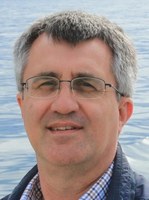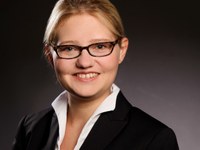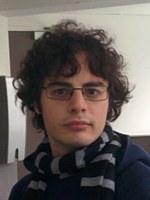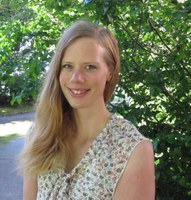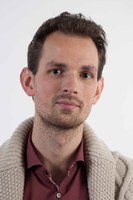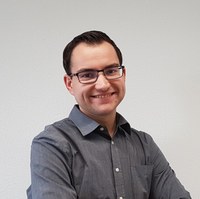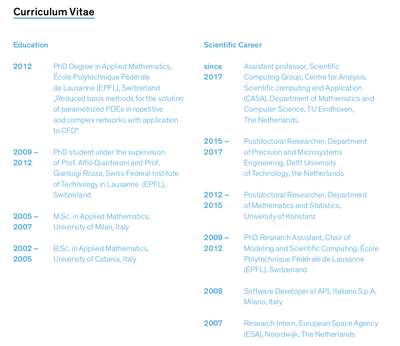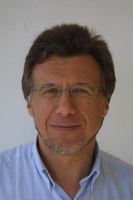2018 Spring Meeting
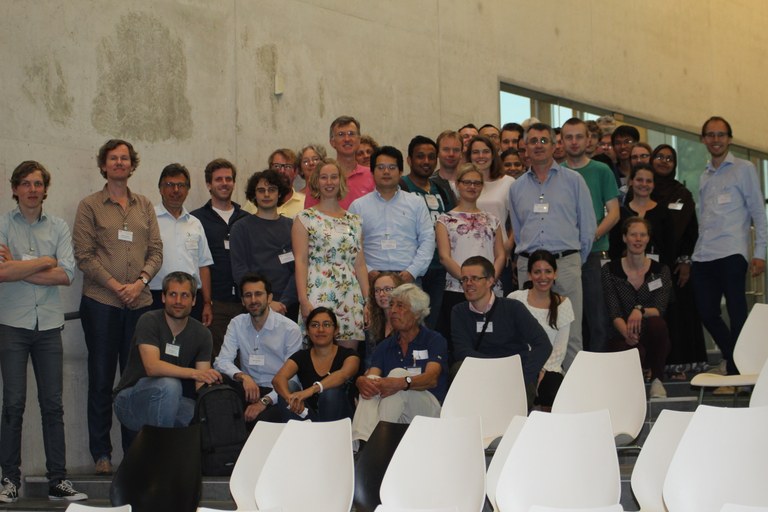
Participants of the 2018 Springmeeting at TU Eindhoven
Friday June 1st, 2018, the Dutch-Flemish Scientific Computing Society (formaly known as Werkgemeenschap Scientific Computing) organised its annual spring meeting. This year it took place at the Eindhoven University of Technology (TU/e), at the location De Zwarte Doos in the TU/e campus.
A mix of young and senior researchers were invited to present their research.
Participation (including lunch) was free of charge. This year we had 46 participants.
Pictures of the 2018 meeting can be found here.
Organization
The spring meeting is organized yearly by the Dutch-Flemish Scientific Computing Society (SCS) formaly known as Werkgemeenschap Scientific Computing (WSC), this year in coorporation with the Technical University Eindhoven.
Organizing comittee: Prof.dr. ir. Barry Koren (TU/e), Dr. Michiel Hochstenbach (TU/e), Dr. ir. Martijn Anthonissen (TU/e), Martine Anholt (CWI, Secretary SCS).
Financial support for this meeting has been obtained from TU Eindhoven. The Dutch-Flemisch Scientific Computing Society is very grateful for that support.
Program
|
09:00-09:25 |
Registration, coffee and tea |
|
09:25-09:30 |
Opening |
|
09:30-10:15 |
Karel in 't Hout (U Antwerpen) |
|
10:15-10:50 |
Kathrin Smetana (U Twente) |
|
10:50-11:20 |
Coffee and tea |
|
11:20-12:05 |
Bas van der Linden (LIME BV) |
|
12:05-12:30 |
Andreas van Barel (KU Leuven) |
|
12:30-13:30 |
Lunch |
|
13:30-13:35 |
Group photo |
|
13:35-14:10 |
Carina Bringedal (U Hasselt) |
|
14:10-14:35 |
Yous van Halder (CWI) |
|
14:35-15:00 |
Roel Tielen (TU Delft) |
|
15:00-15:30 |
Coffe, tea and refreshments |
|
15:30-16:05 |
Laura Iapichino (TU Eindhoven) |
|
16:05-16:50 |
Dirk Roose (KU Leuven) |
|
16:50-16:55 |
Closure |
|
16:55 |
Drinks |
PhDays 2018
We are happy to announce that the PhDays 2018, a special weekend for all PhD students in Scientific Computing from the Dutch and Flemish Universities, will take place again. This is a perfect chance for PhD students to combine the Spring Meeting of the SCS with the PhDays. This year it will be in in Xhoffraix (Belgium). More information about the PhDays can be found here website.
Speakers Spring meeting WSC 2018
|
|
Karel in 't Hout (U Antwerpen) Karel in ’t Hout is Associate Professor in the Department of Mathematics and Computer Science at the University of Antwerp, specializing in the analysis and development of numerical methods for time-dependent partial differential equations with applications to finance. He has previously held positions as Visiting Professor at Arizona State University and Boise State University and Researcher at Leiden University, CWI Amsterdam and University of Auckland. Karel has also spent time in the industry, working as quantitative analyst at ABN Amro, Amsterdam. He holds a PhD in Mathematics from Leiden University. |
|
|
Kathrin Smetana (U Twente) Kathrin Smetana is Assistant Professor at the Department of Applied Mathematics at the University of Twente. Prior to that appointment she worked as a postdoctoral associate in the Group of Prof. Dr. Mario Ohlberger in the Department of Applied Mathematics at the University of Münster, Germany and in the Group of Prof. Dr. Anthony T. Patera in the Department of Mechanical Engineering at the Massachusetts Institute of Technology, United States. Smetana holds a PhD in Mathematics from the University of Münster. The main focus of her research is model reduction for partial differential equations and randomized algorithms for numerical simulations.
|
|
|
Bas van der Linden (LIME BV) |
|
|
Andreas van Barel (KU Leuven) |
|
|
Carina Bringedal (U Hasselt) Carina Bringedal is a postdoctoral researcher at Hasselt University, focusing on upscaling and analysis of mathematical models for porous media flows. In 2015 she obtained her Ph.D. degree in applied mathematics from University of Bergen, Norway, where her thesis concerned heat transport problems in porous media, motivated by geothermal energy extraction. After finishing her Ph.D., she worked as postdoctoral researcher at the Bjerknes Centre for Climate Research in Bergen, focusing on statistical analysis of North Atlantic currents variability, before moving to Hasselt in 2017. She now works with Professor Sorin Pop at the FWO-funded DynScale project, which addresses porous media flows including evolving interfaces at the micro scale.
|
|
|
Yous van Halder (CWI) Yous van Halder studied Applied Mathematics at the University of Technology Eindhoven. Interest in fluid mechanics problems emerged after an internship at the Centre for Turbulence Research (Stanford University). In 2016 he joined the SLING program as a PhD at CWI in Amsterdam, and he works on developing uncertainty quantification methods for fluid mechanics problems. He is supervised by dr. ir. B. Sanderse and prof. dr. ir. B. Koren. |
|
|
Roel Tielen (TU Delft) Roel Tielen is a PhD researcher in the department of Applied Mathematics, section Numerical Analysis of TU Delft. He is working in the field of Isogeometric Analysis (IgA) with applications in the Material Point Method (MPM). Furthermore, his research focusses on efficient solvers for IgA, in particular multigrid-based solvers.
|
|
|
Laura Iapichino (TU Eindhoven) [slides] |
|
|
Dirk Roose (KU Leuven) Dirk Roose is professor in scientific computing and mathematical engineering in the NUMA section of the department of Computer Science of the KU Leuven, Belgium. His research interests are numerical methods and software for high performance computing, multiscale simulation in materials science and nonlinear dynamical systems. He teaches courses on numerical mathematics, parallel computing, computational geometry, nonlinear systems, genetic algorithms and evolutionary computing. Currently, he is chairman of the `users committee’ of the VSC (Vlaams Supercomputer Centrum).
|
Abstracts
Karel in 't Hout (U Antwerpen)
Splitting methods for multi-dimensional advection-diffusion equations arising in financial mathematics
Operator splitting methods form state of the art methods for the efficient and stable numerical solution of time-dependent multi-dimensional advection-diffusion equations arising in contemporary financial mathematics, see e.g. [1]. In particular, alternating direction implicit (ADI) schemes and implicit-explicit (IMEX) schemes are widely employed in financial practice. In this talk we give an overview of the theory and application of such methods, addressing problems such as the valuation of European- and American-style options where the underlying asset price evolution is modelled by a stochastic volatility model.
[1] K.J. in ’t Hout: Numerical Partial Differential Equations in Finance Explained. Palgrave Macmillan (2017)
Kathrin Smetana (U Twente)
Randomized Model Order Reduction
During the last decades (numerical) simulations based on partial differential equations have considerably gained importance in engineering applications, life sciences, environmental issues, and finance. However, especially when multiple simulation requests or a real-time simulation response are desired, standard methods such as finite elements are prohibitive. Model order reduction approaches have been developed to tackle such situations. Here, the key concept is to prepare a problem-adapted low-dimensional subspace of the high-dimensional discretization space in a possibly expensive offline stage to realize a fast simulation response by Galerkin projection on that low-dimensional space in the subsequent online stage.
In this talk we show how randomization as used say in randomized linear algebra or compressed sensing can be exploited both for constructing reduced order models and deriving bounds for the approximation error. We also demonstrate those techniques for the generation of local reduced approximation spaces that can be used within domain decomposition or multiscale methods.
Bas van der Linden (LIME BV)
Scientific Computing in the age of Data: tales from industry
Andreas van Barel (KU Leuven)
Robust Optimazion of PDEs using Multilevel Monte Carlo methods
We discuss optimization problems constrained by partial differential equations with uncertain coefficients. In particular, we show our approach to tackling the standard robust control problem for a tracking type cost functional with an additional penalty on the variance of the state. The expressions for the gradient and Hessian corresponding to this problem contain expected value operators. To be able to deal with a potentially large number of uncertainties, we evaluate these expectations using a multilevel Monte Carlo (MLMC) method. We show that the use of certain correlated samples can reduce the total number of samples required. The convergence behavior is illustrated using a gradient and a Hessian based optimization method for a model elliptic
diffusion problem with lognormal diffusion coefficient. The evolution of the variances on each of the levels during the optimization procedure leads to a practical strategy for determining how many and which samples to use in order to obtain a given tolerance on the gradient norm.
Carina Bringedal (U Hasselt)
Pore scale modeling of porous media flow including moving boundaries
Porous media flows are usually modeled at the zoomed-out Darcy scale, where solid and fluid are indistinguishable and the flow is described in an average manner. Darcy’s law for flow in a porous medium relies on the effective parameter permeability, whose value can be difficult to determine. An alternative approach is to instead zoom in to the pore scale, where solid and fluid can be separated, and describe the fluid flow through Navier-Stokes. Through analytical upscaling using homogenization, explicit expressions for the permeability can be derived under certain conditions. The flow becomes more complicated to describe when moving boundaries are involved; if mineral precipitation and dissolution occur, the structure of the porous medium evolves and there is a moving solid-fluid interface. In this case the permeability will change. If there are two fluids flowing through the porous medium, there is a moving fluid-fluid interface, and the relative permeability of the two fluids will change. We cover various pore scale descriptions for these two cases including moving interfaces, and what to take into account when upscaling the pore scale models to Darcy scale.
Yous van Halder (CWI)
Adaptive uncertainty quantification with application to fluid dynamics problems
Key Words: Uncertainty quantification, Semi-intrusive, Adaptive sampling, Multiphase flow, Fluid dynamics, PDE residual.
A novel approach for the forward propagation of parametric uncertainties in partial differential equations (PDEs) is proposed. Classically, non-intrusive uncertainty quantification (UQ) is based on sampling from a black-box solver and used to construct a surrogate model in the parametric space, from which one can extract stochastic properties of the uncertain solution. Existing methods solely use the black-box solver as a tool to sample from the model. Fully intrusive UQ methods require the underlying model equations to be altered, which removes the possibility of using highly optimised black-box solvers.
However, when the underlying model is given in terms of a PDE, then information from the residual of this PDE can be used to effectively refine the surrogate model, by placing extra samples in the parametric space where the residual is high.
Where L is the PDE operator, the surrogate, the right-hand-side of the PDE and the uncertain parameters. This procedure requires only a slight alteration of the black-box, such that it not only returns the solution value, but also the partial derivatives of the solution with respect to the spatial/temporal-coordinates, as present in the PDE. These derivatives are used to compute the PDE residual when using the surrogate as a solution. This results in a method, which tries to minimise the residual and therefore the error with respect to the exact solution in parametric space. The magnitude of the residual is not only useful to adaptively sample the model, but it also serves as a reliable error measure. The fact that we use knowledge of the underlying PDE results in a method, which is more efficient than classical non-intrusive approaches, such as stochastic collocation. The proposed method is demonstrated by applying it to several fluid dynamics problems.
Roel Tielen (TU Delft)
Efficient multigrid based solvers for Isogeometric Analysis
Introduced in [1], Isogeometric Analysis (IgA) has become widely accepted in academia and in- dustry. However, solving the resulting linear systems remains a challenging task. For instance, the condition number of the Poisson operator scales quadratically with the mesh width h, but, in contrast to standard Finite Elements, exponentially with the order of the approximation p [2]. The performance of (standard) iterative solvers thus decreases fast for higher values of p.
In this talk we propose an efficient solution strategy for IgA discretizations that is based on p- multigrid techniques used both as a solver and as a preconditioner in a Krylov subspace iteration method. The approach makes use of a hierarchy of B-spline based discretizations of different approximation orders, which is in contrast to (geometric) h-multigrid methods, where a hierarchy of coarser and finer meshes is constructed. The ‘coarse grid’ correction is determined at level p = 1, which enables us to use established solution techniques developed for low-order Lagrange finite elements. Prolongation and restriction operators are defined as mappings between arbitrary spline spaces, solely determined by the generating knot vectors, allowing us to combine coarsening in both h and p, leading to a flexible hp-multigrid.
Prelimenary numerical results are presented for different two-dimensional benchmark problems on non-trivial geometries. It follows from a Local Fourier Analysis [3], that the coarse grid correc- tion and the smoothing procedure complement each other quite well. Moreover, the obtained convergence rates indicate that p-multigrid methods have the potential to efficiently solve IgA discretizations.
REFERENCES
[1] T.J.R. Hughes, J.A. Cottrell and Y. Bazilevs, ”Isogeometric Analysis: CAD, Finite Elements, NURBS, Exact Geometry and Mesh Refinement”, Computer Methods in Applied Mechanics and Engineering, Vol. 194, pp. 4135 − 4195, (2005)
[2] K.P.S. Gahalaut, J.K. Kraus, S.K. Tomar. ”Multigrid methods for isogeometric discretization”, Computer Methods in Applied Mechanics and Engineering, Vol. 253, pp. 413 − 425, (2013)
[3] U. Trottenberg, C. Oosterlee and A. Schu¨ller. Multigrid Academic Press, 2001
Laura Iapichino (TU Eindhoven)
Reduced basis method for efficient model order reduction of optimal control problems
Dirk Roose (KU Leuven)
Multi-scale simulation of plasticity and application to metal forming
Forming processes of metallic materials involves large plastic deformations. The prediction of the deformation is typically done by means of the finite element method (FEM), with an appropriate model of the material properties. For an accurate prediction, the plastic anisotropy property must be taken into account. This anisotropy emerges mainly due to the preferred orientations of the crystallites in the polycrystalline material, referred to as ‘texture’. Therefore, the macroscopically relevant material properties are controlled by micro-scale features. On the other hand, the macro-scale deformation alters the crystallographic texture, so two-way coupling of the models at the various scales is needed to resolve the interaction.
The two-way coupling typically uses the fine-scale model in an RVE (Representative Volume Element) to provide in-situ material properties to the macro-scale FEM. However, the computational cost of this approach is very high. To overcome the computational limitations we have developed at KU Leuven a Hierarchical Multi-Scale (HMS) model and software, that uses an intermediate meso-scale model, i.e. an analytical plastic potential function, that is constructed from (many) virtual experiments with a micro-scale RVE polycrystalline plasticity model.
This plastic potential function must be adaptively reconstructed upon a sufficient change of the crystallographic texture. To further reduce the computational cost, we exploit the low variance of the macroscopic solution often present in certain parts of the mesh. We discuss how spatial clustering of integration points in the macroscopic FEM model can be used to adaptively group integration points of RVEs that share similar fine-scale state and by consequence deliver nearly identical macroscopic material properties. We indicate to which extent this clustering allows to reduce the spatial resolution of material property predictions without significant loss of accuracy.

